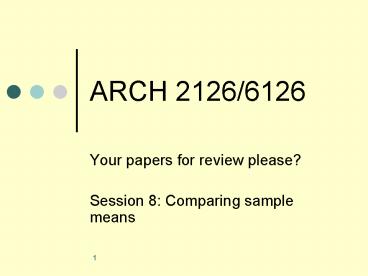ARCH 21266126
1 / 17
Title: ARCH 21266126
1
ARCH 2126/6126
- Your papers for review please?
- Session 8 Comparing sample means
2
Imagine, then, two batches of numbers...
- ... representing, say, lengths of scrapers
excavated from two sites - Are they the same or different?
- Most unlikely to be exactly the same
- Are they similar enough that they could be two
samples from one population? - Or are they different enough to make that a very
unlikely explanation?
3
We have reviewed some theoretical considerations
- Re-sampling central limit theorem
- Statistical significance
- p-values low p high significance
- The problem of many tests
- Type I and type II errors
- Sir R.A. Fisher the magic of 5
- Classical statistics versus exploratory data
analysis
4
So how do we reach a p-value hence a
conclusion?
- A formal statistical test
- E.g. a t test (Students t)
- Special case of Analysis of Variance
- In general the appropriate test for cases like
the 2 batches of numbers, scraper lengths or
human statures - H0 the 2 batches have equal means
- H1 they have different means
5
t refers to a distribution, like the normal
distribution
- Or rather, a set of distributions
- A different distribution for each possible sample
size or rather each degree of freedom (d.f.) - Degrees of freedom n 1
- The larger the sample, the more t resembles the
normal (z) distribution - For n ? 30, they are virtually the same
- For n ?, they are the same
6
(No Transcript)
7
The formula looks intimidating
- Its given in both Drennan (p.156) and Madrigal
(p.98) - But to calculate t all you need to know is--
the sample size- the mean - the variance (or
SD)of each sample - We have already practised getting these from raw
data
8
Here is the procedure in words for the (unpaired)
t test
- To test the hypothesis that two samples could
have been drawn from the same population, or two
populations with the same mean - Calculate the difference between the means
- Calculate the joint standard error of the means
- Divide the first by the second
9
Now lets do it with an example Drennans (p.150)
- Calculate pooled standard deviation
- ((n1-1) x s12) ((n2-1) x s22)
- Divide this by (n1 n2 2)
- Take the square root to get Sp
- Multiply by square root of (1/n1 1/n2)
- This is pooled standard error SEp
10
(No Transcript)
11
To complete calculation of t
- We scale the difference between the means by SEp
- I.e. t (X-bar1 X-bar2)/SEp
- When we have this number, we have t
- What does it mean?
- Look up in table (p.125)
- Gives probability of finding such a difference by
re-sampling one popn
12
(No Transcript)
13
More specifically
- The outcome is a number, a value of the test
statistic - E.g. t -3.66 (a different example)
- We also need the degrees of freedom, a number
usually closely related to the sample size for
t, the two sample sizes summed e.g. 7 8 2
13 - We need to know whether to apply a one- or
two-tailed test (normally two)
14
You can also use
- A statpack e.g. SPSS
- Or website e.g. http//home.clara.net/sisa/index.h
tm - Or even just Excel (calculate the long way, then
check against TTEST which returns p-value) - Round as late as possible
- Checking is good
15
Interpreting the outcome
- From value of t plus d.f. we can get a p-value
from a look-up table or an electronic source
e.g. 0.01gtpgt0.001 - We should normally report- the value of the test
statistic - the degrees of freedom- the p-value
or significance level - Hence in this case t 3.66, d.f. 13,
0.01gtpgt0.001
16
Assumptions of the t test
- Random sampling
- Independence of observations and samples
- Data are normally distributed
- Variances are homogeneous (or not)
- If these conditions are significantly violated,
need to discuss this with your statistical adviser
17
This is the unpaired t test
- Other forms of the t test exist
- Comparison of a single observation with a sample
mean - And paired samples t test (simpler) for use when
repeated measures are being taken on the same set
of cases - t special case of analysis of variance
- These are all univariate statistics






























![Read [PDF] Full-Arch Implant Rehabilitation](https://s3.amazonaws.com/images.powershow.com/10086235.th0.jpg?_=202407261012)
